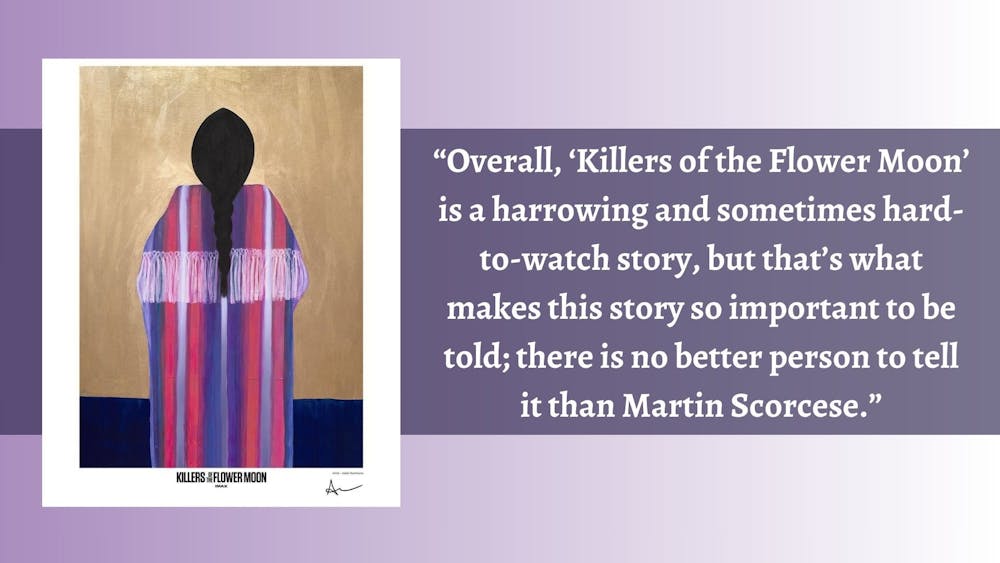“Killers of the Flower Moon,” Martin Scorcese’s latest entry to his storied film career, is a solemn tale about evil's openness and greed's overwhelming vice.
The film focuses on Ernest Burkhart (Leonardo DiCaprio), a World War I veteran, who returns from the war to Fairfax, Oklahoma, to live with his uncle William “King” Hale (Robert De Niro).
Partly due to his uncle's wishes, Ernest falls for and marries Molly Kyle (Lily Gladstone). Molly is a member of the indigenous Osage tribe and, more importantly to Ernest and William, she and her family possess exceptional wealth in the form of oil headrights. Soon, Ernest and Molly become embroiled in an intense and violent conspiracy against the Osage people.
The performances in “Killers” are impeccable. DiCaprio delivers what could be the finest performance of his career. Rarely has such an unscrupulous, morally dubious and frankly unintelligent character been played with such an impactful raw, human emotion that makes Ernest all the more complex.
Despite consistently being overlooked during the Oscars season, DiCaprio could easily win his second Best Actor award.
Even with a powerhouse performance from DiCaprio in “Killers,” he is far from carrying the rest of the cast. De Niro delivers a stellar performance as William Hale, seemingly to remind everyone why he is Scorcese’s go-to man.
Hale is one of the most wicked antagonists put to screen in recent memory because of his charm and pleasantries disguising his brutal means and ends. A wolf in sheep’s clothing for the Osage people, De Niro plays this brutal, two-faced sociopath with silver-tongued excellence.
Gladstone delivers a gutwrenching performance imbuing her character with a heart and strength that feels real. Overall, every performance in “Killers” brings the character to life and works together to envelop the audience in the film’s story.
The realness of the characters in “Killers” is greatly helped by the natural dialogue and the spaciness of the shots. This is Scorcese’s passion piece, and he has no problem indulging in it for as long as he can. Clocking in at 3 hours and 26 minutes, “Killers” is a long, all-encompassing story.
Despite its runtime, “Killers” rarely drags in pacing, effectively using its time to give space to crucial character developments and plot points while also giving the actors space to engage in more natural-feeling conversations.
Even though “Killers” doesn’t face many pacing problems, its gargantuan runtime can be an endurance test for the audience. But there are almost no scenes that feel unnecessary, making an intermission seem like the most logical option for giving audiences some much-needed brevity.
Despite its nonfiction basis, “Killers” feels almost like a parable or morality tale. It is built to horrify.
Enjoy what you're reading?
Signup for our newsletter
The violence is matter-of-fact and treated as almost business by the killers, paradoxically making it all the more visceral and shocking for the audience. Scorcese’s masterful use of violence, especially its impact on characters, elevates the film beyond using violence for shock value by giving it an explicit narrative purpose.
The violence of the film is not the only part of the film that’s disturbing — the casual and often blunt culture of the time is almost equally horrifying. The set design and costuming of “Killers” are unbelievably detailed and create a truly immersive environment for the audience.
Working in tandem with these design elements is an unflinching script that accurately depicts the historical attitudes of many Americans during the 1920s, particularly toward indigenous people in North America. The discomfort of hearing racist attitudes and statements toward the Osage people only amplifies the effectiveness of “Killers” as a morality tale by reminding its American audience that this horrific story of vice they are watching is in fact true.
There are no real winners in “Killers.” Even the audience gets left with solemn ruminations and a bitter taste in their mouths as the credits roll.
This is a bleak story set in a bleak landscape, masterfully elevated by Academy Award-nominated cinematographer Rodrigo Prieto. Prieto’s shots, especially of the Oklahoman hills, are tragically gorgeous, contrasting the desolation of rural Oklahoma with the state’s natural beauty.
“Killers of the Flower Moon” is a harrowing and sometimes hard-to-watch story, but that’s what makes this story so important to be told. There is no better person to tell it than Martin Scorsese, who makes full use of his skill and creative team to create a technical masterpiece with spellbinding performances, unforgettable shots, and spectacular attention to detail. A true labor of love, a passion project and a must-see.
Rating: 10/10




